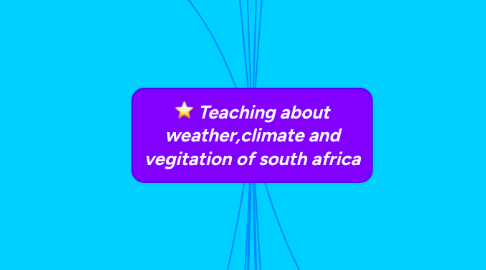
1. HOW TO INTERPRETE A WEATHER CHART
1.1. Weather charts show atmospheric pressure and are used to make weather forecast
1.1.1. The letter H is used for high pressure áreas , or anticylones.
1.1.2. The letter L shows low pressure áreas , or depressions
1.1.3. Lines called isobars connect áreas with the same atmospheric presure.
1.1.4. Cold fonts are shown as blue lines with small triangles , and warms fronts as red lines with small semicircules.
2. FACTORS THAT INFLUENCE CLIMATE
2.1. Air masses
2.1.1. In the lower layers of the atmosphere, air separates into air masses, wich differ in temperatura and humidity.
2.2. Lattitude
2.2.1. The sun's rays reach the Earth at a more direct angle near the Ecuator, so temperatures are higer. The Earth recives much less solar energy near the poles.
2.3. Altitude
2.3.1. At higer altitudes, the air is thinner and losses heat. A difference of 1000 metres leads to a fall of 6ºC in temperature. Consequently, average temperaturas are lower in mountanious areas . Precipitation also increases at higer altitudes.
2.4. Proximity to oceans
2.4.1. Oceans and seas store more heat tan the continentes. Consequentaly, temperaturas are more extreme in land, where there is a bigger difference between máximum and mínimum temperatures. Ocean and sea breezes also increase the humidity of coastal áreas.
3. ATMOSPHERIC PRESSURE
3.1. Is the forcé of the air on the surface of the ground. Depends on altitude, air temperatura and powerful air currents, known as yet strms. We classify:
3.1.1. hot air
3.1.1.1. Is light and not very dense, so it rises easily and créate áreas of low pressure, also called depressions.As hot air ascends, it take wáter vapour with it ,wich cools and condece to form clauds. For this reason, when sky is covered in clouds, depressions form that cause precipitation.
3.1.2. Cold air
3.1.2.1. is heavier and more dense, so it tends to descend. Cold air creates hight pressure áreas, also called anticiclones. Descending air is less humid, which is why anticiclones bring clear skies and dry weather
4. ISOHYETS
4.1. imaginary lines that show rainfall on a map.
4.1.1. there is very high precipitation in the Southern Alps in New Zeland, where it excedes 5000mm annually.
4.1.2. In the Atacama Desert, in Chile, no more tan 0.4mm of rainfall a year is recorded. It is one of the driest places on Earth.
5. TYPES OF RAINFALL
5.1. Convectional rain
5.1.1. A mass of hot air heats up, and then cools as it rises, the wáter vapour condenses and falls as rain. This type of precipitation is found in hot áreas.
5.2. Orographic rain
5.2.1. A mass of moving air meets a mountain and is pushed upwards. It cools as it rises and forms clouds that produce rain.This type of precipitation is found in mountainous áreas.
5.3. Frontal rain
5.3.1. A mass of cold air meets a mass of warm air. The warm air rises above the cold air and becomes cooler. Rainfall is often heavy.This often take place in temperate zones.
6. WINDS
6.1. Wind is a moving air mass and is caused when two places have different atmospheric pressures.
6.1.1. Prevaling winds
6.1.1.1. constant all year round and always blow in the same direction.
6.1.2. Seasonal winds
6.1.2.1. chang direction depending on the seasons, for example, monsoons.
6.1.3. Local winds
6.1.3.1. Affect small geografical áreas and very in intensity depending on the time of day, for example trmontana in Catalonia and the cierzo in Aragon.
7. TEMPERATURE:ISOTHERMS
7.1. Imaginary lines that connect points of equal temperaturas.
7.1.1. The city of Yakutsk is one of the coldest place in the world. In Winter, temperaturas averag -36ºC.
7.1.2. Death Valley record very high summer temperaturas, wich average 38ºC.
8. THE MAIN FACTURES OF CLIMATES
8.1. Temperature
8.1.1. The temperatura is how warm the air is. We measure temperature with a thermometer,and,it usually expresed in degrees centrigrade.
8.2. Wind
8.2.1. The wind is the movement of air masses. It is caused by air currents that are created in zones of different atmospheric pressure.
8.3. Precipitation
8.3.1. The precipitation is the amount of wáter that falls in a place. It may fall as rain, in liquid form, or as skow or hail, in solid form. Precipitation is caused by the condensation of water vapour,wich forms water gravity causes themto fall to the ground.
9. RECORDS
9.1. Lowest temperature
9.1.1. Antartica 1983(-89º)
9.2. Higest temperature
9.2.1. Libya in 1922(57º)
9.3. Most rainfall
9.3.1. Reunión Island in 1966 (1,800mm)
9.4. Oriest place
9.4.1. Atacama desert in chile (1mm of precipitation annually
10. CLIMATE AND WHEATHER ARE NOT THE SAME
10.1. Weather
10.1.1. Weather referes to the metorolical conditions in a place at a specific time.Meteorology is the scientific study of weather
10.2. Climate
10.2.1. Climate is the usual state of the atmosfere over a long period of time. We have different climate zones.Climathology is the sciencetific study of climate
11. LAYERS IN THE ATMOSPHERE
11.1. 1º
11.1.1. Troposphere
11.1.1.1. Meteorological phenomena, such as clouds and precipitation, take plce in this layer.
11.2. 2º
11.2.1. Stratosphere
11.2.1.1. this layer contains the ozone layer that absorbs ultraviolet rays from the sun. This prevents harmful radiations from reachig the Earth's surface.
11.3. 3º
11.3.1. Mesosphere
11.3.1.1. Temperatures are very low. The top part of the Mesosphere is the coldest part of the Atmosphere.
11.4. 4º
11.4.1. Thermosphere
11.4.1.1. The polar auroras occur in the Thetmosphere. Temperatures are very high.
11.5. 5º
11.5.1. Exosphere
11.5.1.1. This is the last layer before outer space. Artificial satellites orbit in the exosphere. Temperatures are very high.
